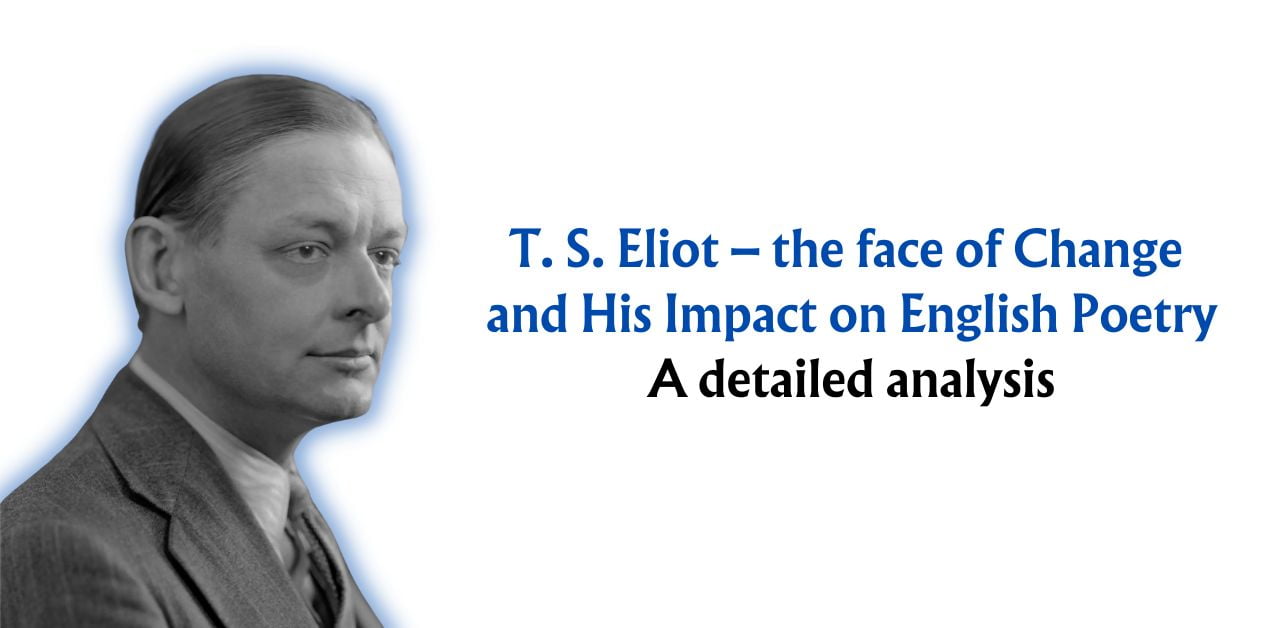T. S. Eliot, the poet who dominated the 20th-century English poetry – an analysis
T.S. Eliot, perhaps, was the only figure in the history of English literature who enjoyed wide and prolonged popularity well within his lifetime, as well as beyond that. In today’s article, I will try to examine the reasons behind Eliot’s immense popularity and also measure his influence on English poetry. It is a well-received fact that T.S. Eliot, a towering figure in 20th-century poetry, revolutionised the literary landscape with his distinct and influential writing style. It was well before his landmark publication, The Waste Land, that Eliot’s writings were discussed widely by critics and aspiring poets. Prufrock annunciated the arrival of this distinct poet. Breaking T S Eliot (or his style of poetry) down into pieces, we will find that through his innovative use of language, fragmented narratives, and complex allusions, Eliot’s poetry left an indelible mark on the poetic tradition of the time. So, we will begin right with Eliot’s impact on 20th-century poetry. Later in this article, I will also discuss the poets who followed his style and analyse the reasons behind Eliot’s enduring popularity and influence.

Impact of Eliot’s Writing Style:
Discussing the impact of Eliot’s writing style on poets and literary personalities of the 20th century, a whole thesis can be written… or perhaps more. However, in this article, I will focus on the apparently visible effect that Eliot’s innovative writing style had and still continues. Particularly 20th-century poetry, after Eliot’s popularity and The Waste Land, ushered in a new era of experimentation and breaking away from conventional forms. Eliot embraced a modernist approach. By employing techniques that challenged traditional notions of poetry, Eliot’s poetic productions exhibited the following key elements:
a) Fragmented Narratives and Multiple Voices: Do you remember The Waste Land, the best example? If you remember it, you must admit that Eliot’s poems often featured fragmented narratives, discontinuous images, and diverse voices. J Alfred Prufrock’s confused identity is a prime example, thereafter, to show that Eliot skillfully blended different perspectives and different voices together, rather skilfully. Historical references and mythological allusions were always there to create a multifaceted and layered reading experience.
b) Juxtaposition of High and Low Culture: If we see two opposing elements together, the impact is severe and it might help us understand the absurdity of one and the importance of another. Eliot skilfully compared two distinct elements using the same method. Many times, Eliot’s poems juxtaposed elements of high culture, such as classical literature and religious texts, with elements of popular culture and everyday language. This fusion created a sense of tension and complexity, reflecting the fragmented nature of the modern world.
c) Intertextuality and Allusions: Credit where it’s due! I remember only John Keats who could hide many things in a single line… but even he could not reach the heights that Eliot reached when it comes to intertextuality. Eliot extensively employed intertextuality and literary allusions, drawing references from a wide range of sources, including Dante, Shakespeare, Hindu ancient texts, Sanskrit works and the Bible. His poems required readers to engage with a vast network of cultural and literary knowledge, adding depth and complexity to his work.
So, these are some of the most visible impacts of Eliot’s writing style that were adopted by many poets after him. Coming to the poets who embraced the techniques used by Eliot, there were many. Nevertheless, there were some who openly exhibited the style in their works rather than keeping it subtle. Some of them are mentioned below.
Poets Influenced by Eliot’s Style:
T.S. Eliot’s unique writing style inspired a generation of poets who sought to emulate his innovative approach. Some notable poets who followed Eliot’s style include:
a) W.H. Auden: Though Auden continued on his distinct pather after a certain time, Auden’s early poems, such as “The Age of Anxiety,” exhibited a similar use of fragmented narratives, cultural allusions, and exploration of modern urban life. If you read the mentioned poem, you can clearly witness the influence of Eliot.
b) Ezra Pound: Pound, a close contemporary and friend of Eliot, not only influenced Eliot but also got influenced by him to a great extent. He shared a commitment to modernist principles. His works, including “The Cantos,” also employed fragmented forms, mythological references, and linguistic experimentation.
c) Wallace Stevens: Stevens was another poet who was influenced by the style of T S Eliot to a great extent. Stevens’ poetry, particularly in his collection “Harmonium,” displayed a blend of intellectual complexity, philosophical exploration, and musicality akin to Eliot’s style.
Reasons for Eliot’s Popularity and Influence:
T.S. Eliot’s popularity and influence can be attributed to several factors:
a) Artistic Innovation: Eliot read many poets and was one the most well-read literary personalities of all time. And therefore, he must have decided to do something different. We can observe, now, Eliot’s works represented a break from traditional poetic forms and subject matters. His exploration of fragmented narratives and intertextuality reflected the fragmented and disillusioned post-World War I era, resonating with the sensibilities of the time. That’s why people loved his innovations and many still read The Waste Land in awe.
b) Philosophical Depth: Eliot’s poetry delved into existential and spiritual questions, discussing themes of identity, alienation, and man’s search for meaning. Man’s search for meaning, existential questions and philosophical investigations are not complete overnight. And therefore, his profound meditations on the human condition resonated with readers and offered a new perspective on the complexities of modern life, and still continue to entice readers of contemporary times.
c) Technical Mastery: Though many might find it contradictory to the other things mentioned above, Eliot did care about form and other technical aspects of poetry. His meticulous attention to form, rhythm, and language showcased his technical skill as a poet. He not only brought a new technique that made space for fragmented narrative, but he also mastered it over time. His use of precise imagery, innovative metaphors, and musicality captivated readers and demonstrated his mastery of poetic craftsmanship.
d) “The Waste Land”: Eliot’s landmark poem, “The Waste Land,” published in 1922, became a touchstone of modernist literature. Its rich tapestry of cultural references, fragmented structure, and haunting imagery captured the disillusionment and despair of the post-war period, cementing Eliot’s status as a literary icon.
To put an end to the flow of thoughts and conclude this article, I will once again reiterate that T.S. Eliot’s writing style had a profound impact on 20th-century poetry. He made sure that there is a break from the traditional style of poetry used by poets hitherto. He guided many poets in using the modern, complex and insinuating style that had more room for readers’ engagement with the literary works. Above all, it was The Waste Land, among many other works by Eliot, that perfectly announced it to the audience – poetry, from now on, would be changed!
by Anand for Desi Readers
